The 10th
LaureateSculpture
Dani Karavan
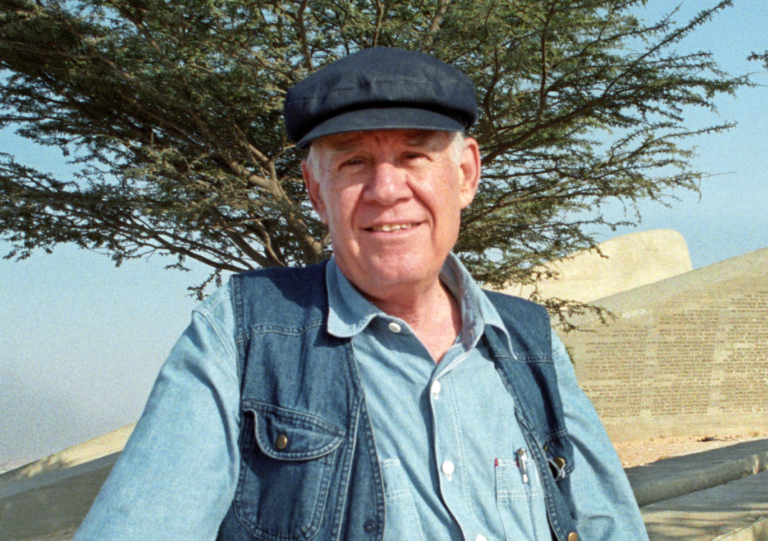
Dani Karavan has become one of the most prolific and adept of public sculptors. His early Negev Monument in Israel is a large-scale essay in the architectural qualities of sculpture; at the Venice Biennale in 1976 his international reputation was confirmed by the Environment for Peace,which included water,olive trees and wind organs. Location is very important to Karavan,not just in terms of landscape,but of history too. The physicality of his creative process is matched to the site: ‘to feel,to listen,to smell,to touch,to walk through’. With Passages,Homage to Walter Benjamin,1990-94,Karavan reached a sublime point of relationship between place (the cultural theorist Benjamin committed suicide at the site),text (some of Benjamin’s own words) and life,in the form of a single carefully-sited olive tree. Such potency is rare indeed in public sculpture.
Biography
The Israeli sculptor Dani Karavan has become internationally famous for large-scale environmental works on idealistic themes. In art historical terms he was deeply influenced by the Japanese-American sculptor Isamu Noguchi and also by the early,surrealist period of Giacometti. One work by Giacometti which he cites as having had an impact on him is The Palace at 4am,1932,which is as much architecture as it is sculpture. The fundamental source of inspiration has,however,been the land of Israel. Karavan speaks of himself as having been ‘born in a country where every stone,every piece of land,is filled with memories,a place where every step forward takes one back tens,hundreds and thousands of years’. He also notes the importance to him of having been a member of a kibbutz. This accustomed him to working in a public space,and made him rebel against the idea of producing goods for a market.
The son of a landscape architect,Karavan studied first in Israel. He continued his studies in Florence and in Paris. Some of his earliest independent work was for the theatre and he has designed sets for the Bat Sheva Dance Company in Israel,for Martha Graham in New York and for Gian Carlo Menotti in Florence and Spoleto. His earliest public sculptures were architectural reliefs,but in 1963 he received the commission for the Negev Monument at Beersheba. As Karavan himself notes,this already anticipates some of the ideas used by the American ‘land artists’ who came to prominence in the late 1960s.
During the 1960s and 1970s Karavan worked in Israel. His international reputation was founded by success at the Venice Biennale of 1976,where his Environment for Peace,with its use of water,olive trees and wind organs,attracted an enormous amount of public attention,as did the symbolic representation of an ideal city sited outside it. The latter was inspired in part by Karavan’s lifelong admiration for the great Italian renaissance master Piero della Francesca. There was another major success at the Kassel ‘Documenta’ held in the following year.
During the 1980s he received a series of prestigious commissions,both in Europe and in Asia. The first of these was Ma’alot,1980–86,at the Ludwig Museum in Cologne,which binds together the most important public spaces in the centre of the city. Others included Axe Majeur,1980,a three-kilometre project at Cergy-Pontoise near Paris,and The Way of Human Rights,1989–93,placed between the old and new wings of the Germanisches Nationalmuseum in Nuremberg. This makes particularly sensitive and imaginative use of a site with extremely complex historical resonances. At the south end of the forum are the ruins of a medieval gate. At the north end is a white concrete gate created by Karavan which is a simplification of the forms of the medieval structure. Between the two stands a row of 27 white columns,each bearing a text from the Declaration of Human Rights,plus two round plates embedded in the ground and one on an oak tree,also with inscriptions from the same source,thus completing the Declaration’s 30 paragraphs. The first paragraph,which appears on the first column,is in both German and Yiddish; a total of 28 other languages are also used.
In 1987 Karavan received his first commission for a site in the East of Asia – for the Olympic Sculpture Park at Seoul. This was followed,the next year,by a visit to Japan. Karavan was profoundly moved by Japanese culture: ‘It seemed then as if I looked in the mirror and saw into myself. Perhaps because my journey began so long ago,because Asia is my continent,because the roots always touch the earth and pass its energy through the body upwards. In Japan I tried to touch holiness,to touch your Japanese “Ma” (concept of space),which also became mine.’
In the 1990s he carried out a number of major projects in the country. In 1994–95 there was a touring exhibition which visited seven Japanese museums. Karavan designed an installation for each one which created a dialogue with the architecture,the natural environment and,sometimes,with a piece from the permanent collection of the museum,such as a painting by Millet in the Yamanashi Museum of Art. He also created permanent sculptural environments for the Miyagi Museum of Art,Sendai,1993–95,and the Nagai Stadium,Osaka,1996–97.
When speaking of what he does,Karavan emphasises several things. First,the physicality of his creative process,and its responsiveness to the actual site – ‘to feel,to listen,to smell,to touch,to walk through’. Each work is conceived for its location and can only belong to one particular place. Living,moving elements such as trees,water and wind,are of primary importance. One of Karavan’s favourite works is also one of his simplest – Passages,Homage to Walter Benjamin,1990–94. Located at Port Bou in Spain,where Benjamin committed suicide while fleeing the Nazis,this is next to the communal graveyard where Benjamin is buried. It is made of very diverse elements – a single olive tree growing in the corner of the graveyard itself; an inscription with some of Benjamin’s own words; and a plunging steel tunnel which focuses attention on the lashing energy of the sea. Going down this tunnel,the visitor performs a short pilgrimage in Benjamin’s memory. It is this ‘passage’ from one place or situation to another,more than any of the physical elements,which is the point of the memorial.
Edward Lucie-Smith
Chronology
East - West,environment for a peace meeting between Palestinians and Israelis
Dani Karavan. Ma'alot, Museumsplatz Koeln 1979-1986 / Christoph Brockhaus. Koeln : Museen der Stadt Koeln. 1986.
-
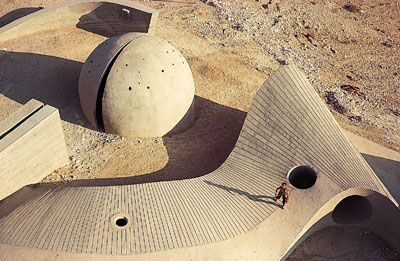
Negev Monument (detail)
-
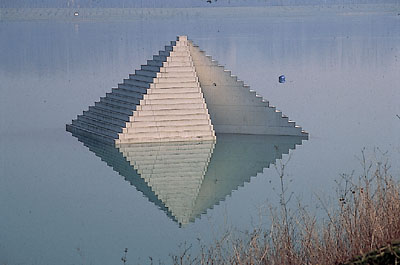
Axe Majeur (detail), 1980-
-
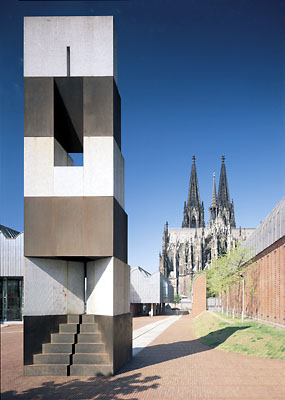
Ma’alot, 1980-86
-
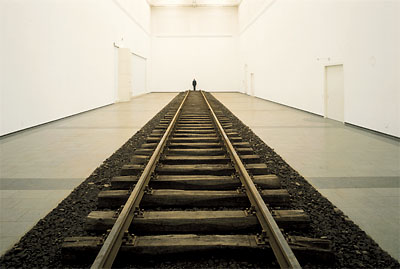
Untitled, 1990
-
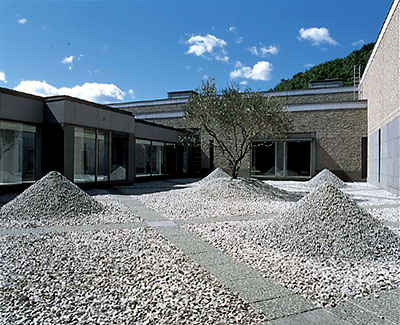
Four Hills, 1995
-
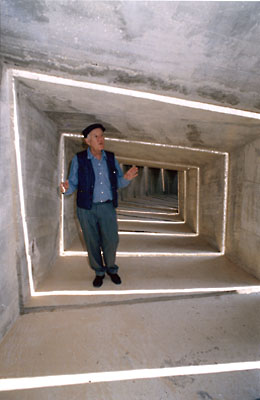
Karavan at the Negev Monument

